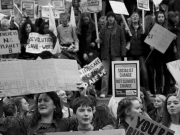David Rozado holds a Ph.D. in Computer Science from the Autonomous University of Madrid and is a widely published author in that field. Prof. Rozado has been teaching at New Zealand’s Otago Polytechnic since 2015; [email protected]. His research interests are computational content analysis and accessibility software.
Introduction
This work examines word frequency usage in New York Times articles written between January 1, 1970 and December 31, 2018. Charting word frequencies in a diachronic corpus tracks the time course of historical events and highlights the dynamics of social trends within the cultural context where the texts were produced. My analysis focuses primarily on tracking the frequency of words that describe negative human experiences and prejudice such as oppression, bullying, marginalization, racism, sexism or homophobia. The results show that the usage of those and related terms in New York Times content has mostly undergone a significant relative increase, particularly within the last decade. The trend precedes the emergence of Donald Trump as a U.S. presidential contender in 2015, but is perhaps reinforced by it. Nevertheless, the increasing prevalence of the analyzed terms in New York Times journalistic discourse is at odds with several social surveys that have documented the decreasing prevalence of racial and sexual prejudice in U.S. society.1
Whether this upward trend in the usage of terms describing prejudice and victimization is the result of changing viewpoint orientation among New York Times journalists or rather it reflects changing norms and attitudes within the New York Times readership or the wider society is beyond the methodological scope of this work and remains an open question. The trends highlighted here however provide supporting evidence for several hypotheses and experimental results published previously that also studied the same or similar phenomena to those discussed here, namely: “victimhood culture,” “concept creep,” and “prevalence induced concept change.”
Victimhood Culture
In “Micro-aggressions and Moral Cultures,” Bradley Campbell and Jason Manning argue that Western societies have recently experienced a large-scale moral change culminating in what the authors named “victimhood culture,” distinct from previous “honor” and “dignity cultures.”2
Campbell and Manning describe “cultures of honor” as those that tend to emerge in situations where legal authority is absent and where reputation for retaliation acts as a deterrent against predation. In honor cultures, individuals display a low threshold for tolerating offenses and act aggressively to protect their reputation. The growth of law and order in the West facilitated, according to Campbell and Manning, a transition from a culture of honor to a culture of dignity.
The same authors argue that cultures of dignity are driven by the values of restraint, toleration, negotiation, and compromise as primary means of navigating interpersonal friction. If occasional unresolvable conflicts arise, dignity cultures prescribe the use of courts rather than direct violent retribution. The authors maintain that the rise of “microaggression” complaints and demands for “trigger warnings” and “safe spaces” within university campuses, corporations, and other social institutions suggest that Western countries might be transitioning from a dignity culture into a “culture of victimhood.”
Campbell and Manning propose that victimhood culture is characterized by individuals and groups displaying high sensitivity to slight indiscretions, even if unintentional, and heavy reliance on third parties to mediate in interpersonal conflict. The authors caution that victimhood culture can be weaponized as a conflict strategy where the aggrieved cultivate an image of victimhood to attract the support of third parties. The authors also note that any interpersonal dispute that can be misconstrued as a collective offense against a distinct demographic group (ethnic, religious, sexual, etc.) will increase its chances of attracting third-party intervention.
Within a victimhood culture, Campbell and Manning caution that there are social enticements to emphasize personal or group disadvantage and social marginalization since victimhood confers moral status. But whenever victimhood confers stature they note, the incentives for claiming victimhood status rise. Thus, individuals and groups might sometimes exaggerate or even falsify offenses in order to raise their rank in the victimhood hierarchy. There is some evidence that hate crime hoaxes are indeed on the rise.3 Paradoxically, Manning and Campbell note that victimhood culture is more acute in places that are already highly egalitarian such as elite university campuses. In such settings, derogatory acts towards minorities are rare, but minor slights, or even fabricated ones, can cause major outrage.
Concept Creep
The work from Nick Haslam introduced the term “concept creep” as a way of describing how concepts that refer to negative aspects of human experience and behavior have recently expanded their semantic boundaries so that they now encompass a much wider range of phenomena than in previous times.4 That semantic elasticity has taken what the author describes as horizontal and vertical forms
According to Haslam, concepts have extended outward (horizontally) to capture qualitatively new phenomena and downwards (vertically) to capture quantitatively less extreme phenomena by relaxing the threshold for what qualifies as an instance of the phenomenon. The author illustrates concept creep using terms taken from the psychological literature that exemplify semantic dilation over time. In particular, he focuses his analyses on the terms abuse, bullying, trauma, mental disorder, addiction, and prejudice.5
Haslam reviews, for instance, how the classical usage of the term “abuse” in the realm of psychology used to recognize just two forms, physical and sexual, and was constrained to describe abusive behavior of adults towards children. In recent decades however, the emergence of the term “emotional abuse” to describe nonphysical mistreatment such as verbal aggression or emotional unresponsiveness represents an example of horizontal expansion of the term.
Prejudice is another example of a term that has experienced concept creep. The term has traditionally referred to intergroup animosity such as endorsement of hostile and derogatory statements about African Americans. However, as the prevalence of prejudice decreased in the second half of the twentiet0h century,6 the semantic loading of all forms of prejudice has expanded. Some scholars have pushed to broaden the definition of racism to include intellectual positions such as the denial of its continuing existence or opposition to affirmative action policies. Prejudice has also been expanded to encompass subconscious phenomena manifesting themselves in subtle ways, such as psychological reactions experienced below the threshold of self-awareness, said to be measured through the Implicit Association Test (IAT).7 Substantial doubts about IAT validity have been raised recently.8 All these represent examples of vertical expansion of the term.
Critically, Haslam notes that determining what counts as emotional abuse or prejudice has recently acquired a larger element of subjectivity, where the self-identified victim, not an external neutral observer, has been used to determine whether prejudice or emotional abuse has occurred. That is, prejudice or emotional abuse might not be inherent in the acts or attitudes of a person accused of engaging in them, but rather exist in the accuser’s subjective perception.
Haslam hypothesizes that the trend of semantic inflation of negative human experiences reflects the hegemony of a liberal moral agenda that is highly sensitive to suffering and maltreatment, and that strives to define new kinds of experience and behavior as hurtful and new identities of people as vulnerable and in need of care and protection.9 Haslam warns, however, that although concept creep might be well intentioned and aims at identifying harm that was previously ignored, its prevalence risks pathologizing everyday experience. This is because concept creep promotes a culture of weakness, fragility, and diminished agency in which most people can be victims and where the meaning of negative concepts are debased, as when people describe ordinary and transient sadness as depression.10 Haslam concludes by asking whether we, as a social collective, want to describe most interpersonal friction as abuse or bullying, denote everyday stresses as traumas, refer to habits as addictions, accept that mental disorders are more common than their absence, and assume that prejudice is a constant hallmark of human intergroup interaction.
Less Means More: Prevalence Induced Concept Change
A causal psychological mechanism for concept creep was proposed in an outstanding work by Levari et al. showing across seven experimental studies what authors called “prevalence-induced concept change.”11 The term describes a human cognitive bias that responds to decreases in the prevalence of a stimulus by expanding the concept of it, thereby masking the magnitude of its own decline.
In their investigation, the authors showed that in an experimental setting where blue dots became less frequent, experimental participants started to judge previously labelled purple dots as blue. That is, when the prevalence of blue dots decreased, participants’ concept of blue expanded to include dots that it had previously excluded. In another experiment, when threatening faces became rare, previously perceived neutral faces began to appear threatening to experimental subjects. In yet another experiment, when unethical research proposals became less frequent, participants started to judge ambiguous research proposals as unethical. This phenomenon occurred even when participants were explicitly forewarned that the prevalence of instances would change, and when instructed and paid to ignore the decreasing prevalence and strive to maintain stable operationalizations of concepts.
Cognitive inability to hold stable mental concepts can be problematic. According to the authors, what counts as a felony, a field goal, or a tumor should not be a function of the prevalence of those instances. That is, in the absence of crime, athletic accomplishment, or cancer, police officers, referees, and radiologists should not expand their concepts of felony, field goal, or tumor and detect them anyway.12 Yet, the results of Levari et al. suggest that institutions and individuals dedicated to identifying and reducing the frequency of negative phenomena may be unable to avoid expanding the definition of concepts whose prevalence is decreasing over time.
Attitudinal Changes in U.S. Society
Over the last five decades, Western societies in general and the U.S. in particular have experienced extraordinary changes in social attitudes with regard to demographic identities such as gender, sexual orientation, or ethnicity. Yet many people fail to acknowledge these changes despite social surveys consistently documenting the marked decrease of phenomena such as prejudicial attitudes against minorities in American society over the past five decades.13 It is well documented that the share of Americans who approve of interracial marriage, desegregation in schools and neighborhoods, and equal access to jobs has grown steadily, while the share of Americans who believe that whites are more intelligent or hard working than African-Americans has decreased. The diminishing trajectory of racial prejudice among white Americans appears to have continued during the first two years of Trump’s presidency.14
Similarly, U.S. attitudes along several dimensions of gender equality such as the role of women in politics, families, and the workplace, as well as perceptions of working mothers, have shown societal attitudes moving toward gender equality beliefs.15 Yet the share of Americans who view racism against minorities and sexism against females as major problems has increased sharply within the last decade, particularly among Democrats.16 This apparent paradox supports the theories of prevalence induced concept change and concept creep. As phenomena such as prejudice against minorities have become less prevalent, the threshold for what counts as an instance of such phenomena decreases and the concept boundaries stretch to encompass a wider range of milder events.
New York Times Chronological Word Frequency Usage
To analyze word frequency usage in New York Times articles over time, a computer program (web spider) was created that automatically crawled the online New York Times domain and collected all articles written between 1970 and 2018. Due to missing data for the year 1980 in the NYT domain, in subsequent analysis the year 1981 is used as a proxy for frequency counts for 1980. The frequency of a word on any given year was estimated by dividing the count of all occurrences of the word in all articles of that year by the total count of all words in all articles of that year. Frequencies were then normalized to the 0 to 1 range by dividing each word’s yearly frequency by the word’s highest frequency in the entire forty-nine years’ time series.
In a chronological data set, word frequency usage is illuminating for tracking historical events and shifting cultural trends over time. For instance Figure 1, subplot 2, shows how this data set perfectly tracks the major wars in which the U.S. has been involved in the studied timeframe (i.e. Vietnam, the first Gulf War, and the Afghanistan/Iraq wars) by simply plotting the frequency of the word “war” in New York Times articles by year. Other events such as U.S. presidential elections for a given candidate (subplot 1), the disappearance of the Soviet Union (3), Olympic Games (4), the Challenger and Columbia space shuttle disasters (5), or the collapse of Enron (6) can also be tracked by plotting the relevant words.
Word frequencies charting is also useful to trace cultural and societal trends such as the rising predominance of immigration and climate change themes in journalistic discourse (7, 8), the rising and dropping fortunes of “new” versus “old” economy corporations such as Google and General Motors (9, 10), the panic surrounding the emergence of the AIDS epidemic that subsequently fades as a consequence of life-saving anti-retroviral therapies (11), the diverging influence of agriculture and technology in modern economies (12, 13) or the ascendance of China as a global superpower (14).
Figure 1
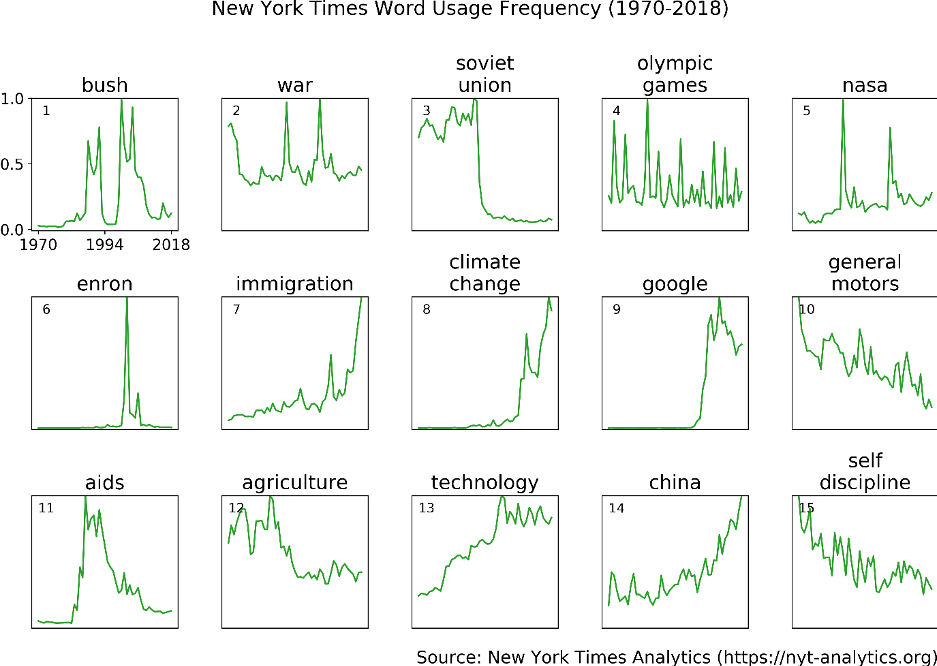
When the lens of analysis is placed on words that describe negative human experiences and prejudice such as bullying, oppression, marginalization, racism, sexism or homophobia, and related terms, a consistently increasing trend is apparent in New York Times articles.
Figure 2 illustrates an extraordinary increase in the number of times that the New York Times writes about prejudice such as sexism, racism, homophobia, Islamophobia, and related terms.
Figure 2
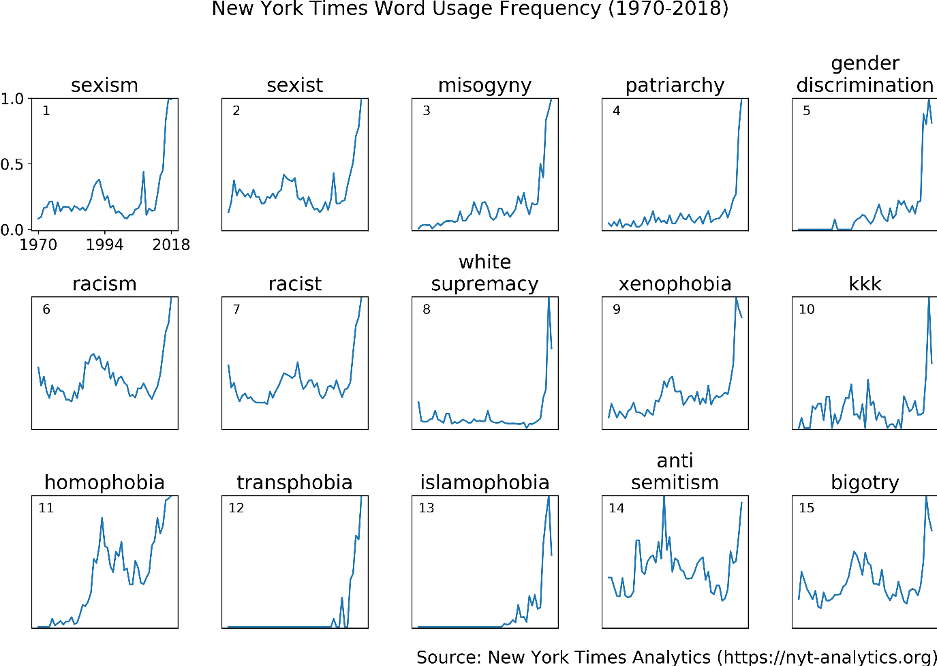
Similarly, Figure 3 reveals that words that describe negative human experiences and that highlight a narrative of vulnerability, victimization, and oppression, such as hurtful (1), traumatizing (3), bullying (5), subjugation (8), marginalization (10), abused (11), offended (13), and related terms have also undergone a remarkable increase in prevalence over time.
Figure 3
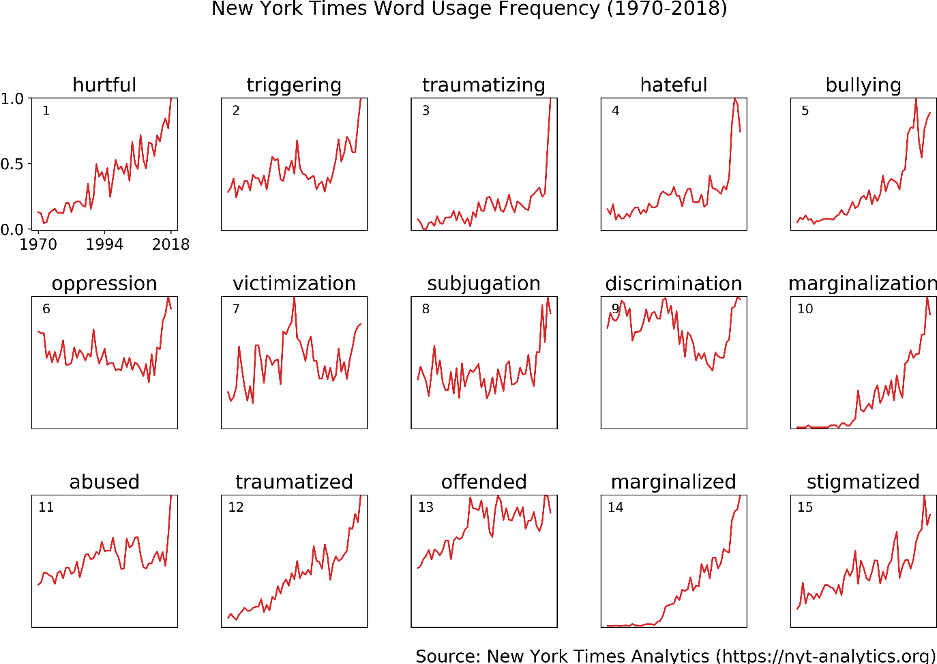
It is important to note that some terms such as hurtful (1), bullying (5), or traumatized (12) in Figure 3 have followed a steadily increasing linear trend over the forty-nine year time range. Yet other terms such as sexism (1), racism (6), or Islamophobia (13) in Figure 2 or oppression (6) in Figure 3, have undergone a large abrupt spike towards historical highs starting around 2013.
As shown in Figure 2, the current historical highs in the usage of words describing prejudice such as sexism, racism, or homophobia was preceded by a similar but milder cycle in the first half of the 1990s. This is not the case however for words describing victimization (Figure 3). Taken together, these non-perfectly synchronous tendencies suggest that although related, each usage trend for the victimization and prejudice word sets results from not completely overlapping causal phenomena.
Finally, Figure 4 illustrates a concomitant phenomenon: the rise of a belief system around the ideas of diversity, equality, social justice, intersectionality, activism, multiculturalism, inclusion, safe spaces and related terms, whose prevalence has also been growing in New York Times content and that is likely related to the trends illustrated in the previous figures.
Figure 4
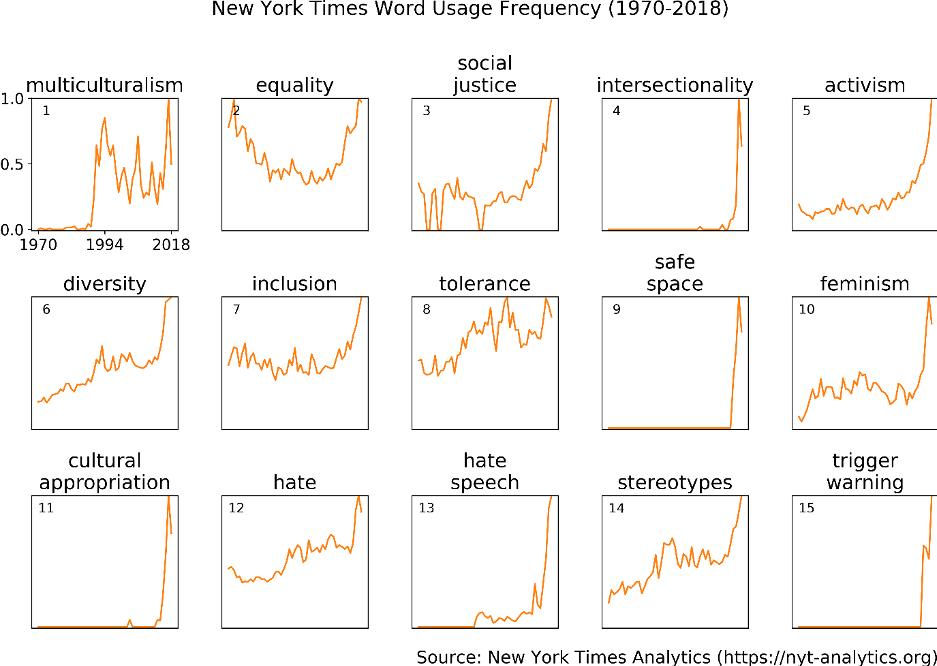
This work also introduces to the public an online tool created to allow others to explore the New York Times data set used in this analysis by plotting their own time series of word frequency usage. The web application can be found at www.media-analytics.org, and is illustrated in Figure 5.
Figure 5
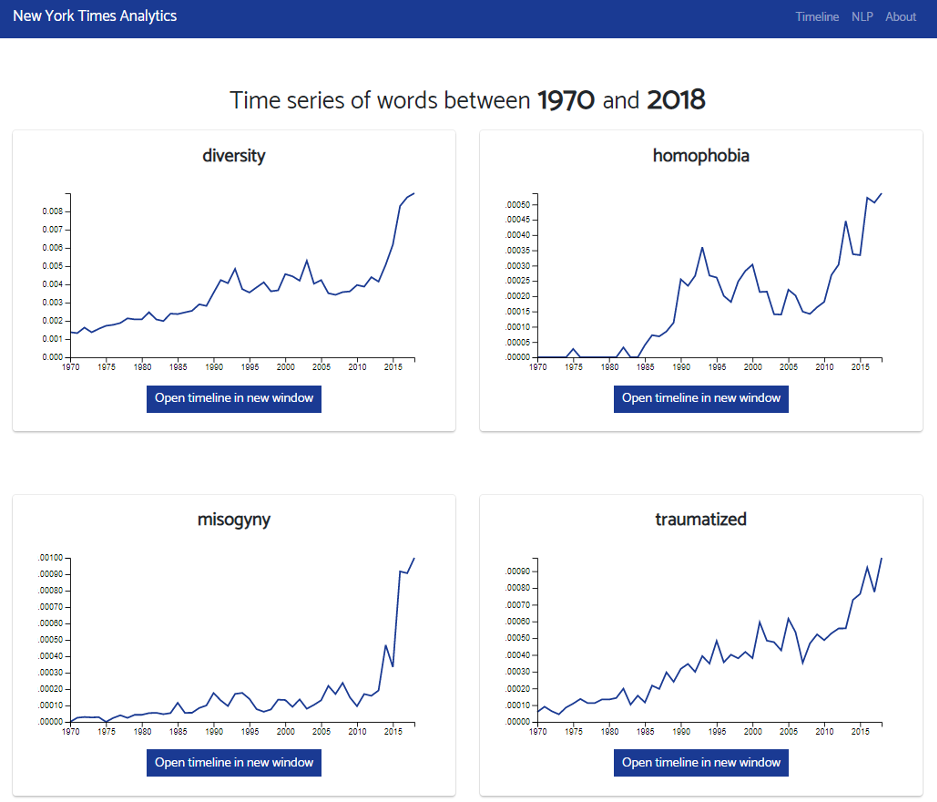
The consistency of the trends illustrated in Figures 2, 3, and 4 and their marked acceleration starting around 2011-2014 is striking, and suggests a major shift in moral culture within the New York Times readership, its editorial board, or within the broader public. Thus, the most urgent question raised by these results is whether the trends illustrated in the Figures above reflect journalists simply echoing changing readership or social attitudes in the direction of more sensitivity to human suffering and intolerance of inequality, or whether these trends reflect a media-fuelled promotion of identity politics and victimhood culture that encourages individuals and groups to cultivate an image of vulnerability and victimization in order to obtain power, sympathy, preferential treatment, or deference.
Additional incentives structures might also be involved in the trends outlined above. In social contexts where the concepts 1-10 highlighted in Figure 4 are treated as sacred values and therefore, to a certain extent, exempt from critical scrutiny,17 some individuals might try to gain moral prestige not by claiming to be victims of prejudice but by ostentatiously denouncing prejudice itself. In such environments, the costs of false accusations or incorrect pessimistic assumptions about prejudice will usually be negligible for the claimant. It is thus conceivable that in the aforementioned circumstances, questionable or even erroneous assumptions about rampant prejudice might not be unusual. If these sorts of environments are becoming more prevalent in social institutions, themes like those highlighted in Figure 2 should be increasingly salient in New York Times content.
The role of colleges and universities in this language prevalence shift should not be overlooked. It is likely that the entrenchment of victimhood culture on university campuses, as described by Campbell and Manning, is percolating into corporate venues as fresh graduates from universities move on and start to fill the ranks of other social institutions and replace retiring baby boomers. However, as usual with observational studies, untangling causality is extremely challenging and should be the goal of future work.
In conclusion, this paper has alluded to the large societal decrease of prejudicial attitudes against protected groups in the U.S. over the past fifty years and contrasted it with the paradoxical increase in the usage of words that describe such phenomena in New York Times content. This pattern provides empirical evidence for the hypotheses of concept creep and victimhood culture.18 The work from Levari et al. about prevalence induced concept change provides hints about a psychological bias that might be partly enabling this phenomenon, although other factors are likely to be at play as well.19
1 S. Krysan, S. Moberg, “Trends in Racial Attitudes,” University of Illinois Institute of Government and Public Affairs, accessed July 13, 2019, https://igpa.uillinois.edu/programs/racial-attitudes#section-5; Kelsey D. Meagher, Xiaoling Shu, “Trends in U.S. Gender Attitudes, 1977 to 2018: Gender and Educational Disparities,” Socius 5 (January 1, 2019).
2 Bradley Campbell, Jason Manning, “Microaggression and Moral Cultures,” Comparative Sociology 13, no. 6 (January 30, 2014): 692–726.
3 See in this issue, Wilfred Reilly, “Are Hate Crime Hoaxers Above the Law?,” Academic Questions 32, no. 4 (Winter, 2019); Wilfred Reilly, Hate Crime Hoax: How the Left Is Selling a Fake Race War (Washington: Regnery Publishing, 2019); Bradley Campbell, Jason Manning, The Rise of Victimhood Culture: Microaggressions, Safe Spaces, and the New Culture Wars, 1st ed. (New York, NY: Palgrave Macmillan, 2018).
4 Nick Haslam, “Concept Creep: Psychology’s Expanding Concepts of Harm and Pathology,” SSRN Scholarly Paper (Rochester, NY: Social Science Research Network, November 14, 2015), https://papers.ssrn.com/abstract=2690955.
5 Ibid.
6 Moberg; Kelsey; Meagher, Shu.
7 AG Greenwald, DE McGhee, JL Schwartz, “Measuring Individual Differences in Implicit Cognition: The Implicit Association Test.,” Journal of Personality and Social Psychology 74, no. 6 (June 1998): 1464–1480.
8 Rickard Carlsson, Jens Agerström, “A Closer Look at the Discrimination Outcomes in the IAT Literature,” Scandinavian Journal of Psychology 57, no. 4 (August 1, 2016): 278–287.
9 Jesse Graham, Jonathan Haidt, Brian A. Nosek, “Liberals and Conservatives Rely on Different Sets of Moral Foundations,” Journal of Personality and Social Psychology 96, no. 5 (May 2009): 1029–1046.
10 Haslam.
11 David E. Levari et al., “Prevalence-Induced Concept Change in Human Judgment,” Science 360, no. 6396 (June 29, 2018): 1465–67.
12 Levari et al.
13 Krysan, Moberg; Pew Research Center, “Most Americans Now Say Learning Their Child Is Gay Wouldn’t Upset Them”; Pew Research Center, “Democrats Increasingly View Racism and Sexism as Very Big National Problems.”
14 Daniel J. Hopkins and Samantha Washington, “The Rise of Trump, the Fall of Prejudice? Tracking White Americans’ Racial Attitudes 2008-2018 via a Panel Survey,” SSRN Scholarly Paper (Rochester, NY: Social Science Research Network, April 17, 2019), https://papers.ssrn.com/abstract=3378076.
15 Meagher, Shu.
16 Pew Research Center, “Democrats Increasingly View Racism and Sexism as Very Big National Problems”; "Larger Shares in Both Parties Say Drug Addiction Is a Major Problem”; Pew Research Center, “More Now See Racism as Major Problem, Especially Democrats,” Pew Research Center (blog), accessed July 12, 2019.
17 Jesse Graham, Jonathan Haidt, “Sacred Values and Evil Adversaries: A Moral Foundations Approach.,” APA PsychNET, 2012, https://doi.org/10.1037/13091-001.
18 Campbell, Manning, “Microaggression and Moral Cultures”; Haslam.
19 Levri et al.
Photo by David Smooke on Unsplash









